Need & Impact
Needs and Impact
- Solve Congestion
- Solve Traffic, Parking and Safety Issues
- Modernize Facilities
- Eliminate the Wait List
- Maintain the Only Small School Option in the Harbor Area
- Provide Housing for the Religious Teaching Faculty
Solve Crowding
The current high school [A] is 30,000 square feet and occupies a corner of the Mary Star of the Sea Parish plant that includes the gymnasium [B], the rectory [C], the church [D], the convent/offices [E], the elementary school [F], and the parking lots on one square city block (3.2 acres). In recent years, the student population at the high school has steadily grown from 256 in 1994 to 460 in the fall of 2001 (113% of capacity). Modular buildings have been added [G], however there is no longer room to expand and conditions in and around the school are extremely crowded.
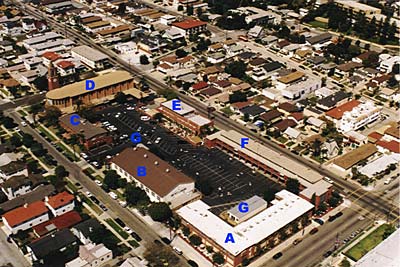
Impact: In contrast, the new campus has eight times the landmass and will have double the square footage in building space. Trees, sky, views, buildings, and open space will join to enhance the quality of life and learning for the students of today and in the future.
Solve Traffic, Parking and Safety Issues
There is no on-campus parking at MSHS. For safety reasons gates are closed during the day. Student parking and traffic is shifted to the surrounding neighborhood creating increased safety issues as passengers are dropped off and picked up. Students who drive compete with the local residents for valuable curbside real estate" and the look of congestion blights the area.
Impact: At the new campus, parking, drop-off and pickup will be on-campus (not in public streets). The process will be much safer and it will take less time with minimal frustration. In the future, the neighborhood streets surrounding the current high school will return to a calm, safe residential use, much to the joy of the local home owners.
Modernize Facilities
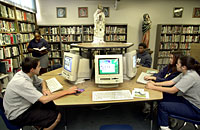
Students with ComputersThe capacity of the fifty-year-old facility has been outpaced by the demands of technology, science, athletics, and extra curricular endeavors.
- The present plant has only one science lab.
- The shelf space in the library is approximately percent of optimum.
- The facility is not "wired" for adequate implementation Of classroom computer technology. Limited computers are available in the already over crowded library.
- There is no fine arts facility nor is there a rehearsal room for choir and drama.
- The high school, elementary school and parish use one auditorium. The same auditorium serves as the gym with a few small bleachers on stage for seating.
- There are no playing or practice fields on campus. Students are continually traveling to and from community fields.
- There is no covered lunch facility (inside or out), no infirmary, and only primitive shower and locker facilities for PE/athletics.
- There is no green space, so badly needed to nurture the inner health of students coming from cramped apartment living.
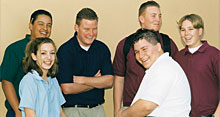
To develop specifications for new facilities faculty, students and parents visited many newer schools in Southern California and reviewed recent literature and research on high school design. The findings, first and foremost, require that the new school must support the learning style of today and adapt for the advancements of tomorrow. The completed facility, to be built in two phases, will accommodate 600 students, and include:
- Twenty classrooms supportive of cooperative learning and video/computer applications.
- Three science labs for convenient demonstrations and experimentation.
- A gymnasium including two full-sized high school basketball courts, male and female locker rooms, a weight room, and athletic office.
- Multipurpose Center with kitchen, performing arts and chapel.
- A library with a computer laboratory to aid research.
- Administration space for faculty, parent board and other groups; administrative offices and secretarial areas; faculty and conference room; and bookstore, copy room and storage areas.
- Student Services space including counseling, activities, student lounge, work room, and infirmary.
Impact: The new campus and facilities will have a major impact on the quality of life and learning for students and faculty. Adding capacity where there has been none will allow programs that have languished to prosper — fine arts, choir, and drama. Increased space will ensure that under served programs can flourish - science, technology, and library research. The entire athletic program will improve with the addition of a full gym, appropriate locker facilities and on-campus fields. By discontinuing the constant travel to various community practice fields, an enormous amount of time will be saved and applied to improving the skills of the young athletes. In addition, the staff and faculty will be far more productive (and happier) with adequate work, meeting, storage, and teaching space.
Eliminate the Wait List
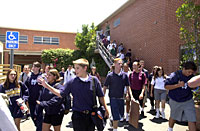
Students Outside GrottoThe qualifications of the faculty, the depth of course offerings, college entrance test scores and the finances of the school have strengthened throughout the 1990s. The list of qualified students seeking admissions continues to increase. In addition, many promising students contact the school about admissions, and, upon learning that there is a wait list, seek other options. They choose not to pay the registration fee and be placed on the wait list.
Impact: With the additional capacity of the new school, the wait list can be eliminated and more students will receive their first choice in the kind of education they desire.
Maintain the Only Small School Option in the Harbor
Today, MSHS is the only small school option in the Harbor area. Because of its small size, the faculty can personally address students and their individual learning needs. By providing specific feedback and directions, greater academic success is achieved. In addition, the small size encourages every student to participate in school activities and to grow as a whole person. The new school will remain small with a planned student population not to exceed 600.
Impact: The benefits inherent to a small high school campus will be maintained and fostered. Those families seeking this environment to support the educational and maturational needs of their children will find the opportunity at Mary Star.
The Los Angeles Times (5/19/99, pg. A17) stated: "Though there is no clear agreement about where ‘small’ leaves off and ‘large’ begins, many researchers say that an optimum size is ... 400 to 800 for a secondary school."
Newsweek (5/10/99, pg. 43) reported: "...high schools work best when enrollment is between 600 and 900. In a school of this size, fewer students are marginalized, and more kids are likely to be part of an extracurricular activity with an adult role model."
Time Magazine (5/31/99, pg. 43) states: "Studies show that students make better grades in smaller schools. They are less likely to be involved in fights or gangs because they know someone is always watching. They are less embarrassed to discuss problems with teachers. They have better attendance, lower dropout rates and more participation in extracurricular activities... shy kids, poor kids, average athletes — they all are made to feel like they fit in."
Provide Housing for the Religious Teaching Faculty
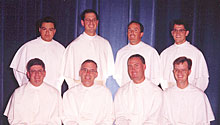
Norbertine Fathers 2000In a time when the national and worldwide trend is for decreasing religious faculty in Catholic schools, Mary Star has experienced the growing presence of the Norbertine fathers. In 1991 Father Norbert Wood was approved as the first Norbertine priest to be assigned as chaplain and teacher. Today there are ten Norbertine fathers at Mary Star and eight are full time on the high school faculty (see photo of faculty). There is little question that these dedicated, prayerful and highly educated men are driving the renaissance at Mary Star. Their exceptional talents and energies both inspire and strengthen the direction, quality and results at the high school.
Formerly, the Norbertine priests lived in the upper floor of the original convent that faces directly onto 7th Street, one of the busiest and noisiest arteries of San Pedro. The lower floors, used for ministry offices and Christian Care Outreach, teem with activity each day from early morning well into the evening.
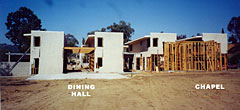
The need existed to provide the Norbertine fathers with private living facilities that are more in keeping with the lifestyle and traditions of their order. To accomplish this, a portion of the new campus was set aside for their use and former Navy buildings (see photo) were remodeled to provide a permanent home. The faculty housing accommodates sixteen permanent residents with three additional guestrooms. The main building includes a private chapel, the common room, the kitchen and refectory. The adjacent building includes a library/study area and an exercise room. The Norbertine fathers took up residence in April, 2001.
Impact: The impact of the privacy and solitude of the new site will be significant for the day to day living of the priests. In addition, their presence on the campus provides an element of security that is essential during construction and in the future.

